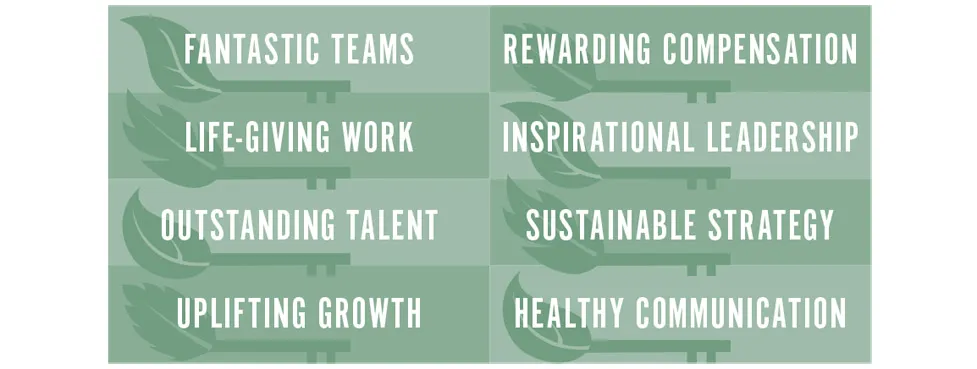One of the most memorable examples to me is an international missions organization I’ll call FMA.1 The ministry was founded and built by a dynamic, pioneering leader, but over time the stress of organizational expansion took a heavy toll on the culture of its home office. By and large, missionaries in the field were supported well and had a good experience, but many employees at headquarters were disengaged, and morale had sunk extremely low.
After the founder moved on from the organization, FMA’s board replaced him with a new president who was willing to take the helm if he could lead from offsite for the first couple of years until he was able to relocate to the organization’s headquarters. The president promptly brought in an executive vice president named Jim to manage the ministry onsite. Jim quickly discovered that the organizational culture was a wreck, so he and Greg, FMA’s vice president of human resources, asked me to help them investigate just how bad things were. They knew that they couldn’t make their ministry better in the future if they didn’t know precisely where they were in the present.
So together we conducted an employee engagement survey to get a read on the workplace culture. When I got the results back, I realized that these two leaders weren’t kidding—the culture was indeed in bad shape. “Guys,” I told them over the phone, “you’re right; this is bad.”
“How bad is it?” they asked.
I didn’t want them to give up in defeat before they started, so I cautiously told them, “You’re in the lower quartile of the organizations Best Christian Workplaces Institute has surveyed.”
“The lowest 25 percent?” they replied. “We knew it was bad; that’s not all that shocking.”
“Well,” I continued, “you’re really in something more like the bottom 10 percent.”
Fortunately, they took that news pretty well too, so I thought they might be ready for the blunt truth. “Okay,” I said, “if you really want to know, your culture might be the worst of any organization we’ve ever worked with!”
To their great credit, the two VPs were undaunted. “Al,” they said, “let’s find out why.”
WHEN A TOXIC CULTURE DOESN’T GO AWAY
Engagement surveys like the one we conducted among FMA’s employees can be very illuminating, but they’re always incomplete without face-to-face dialogue where people can explain why they answered the way they did. So with Jim and Greg’s approval I started to have these candid conversations without management in the room, and employees showed me they had a lot to say.
The most burning issue on their minds—at least on the surface—was wasted talent. “FMA hires great people and burns them out,” said one employee. Of more than fifty statements on the survey, the one FMA’s employees agreed with least was “FMA retains highly qualified employees.”
One young woman’s story was illustrative. One of FMA’s most effective initiatives was a summer experience for college students that took them to the mission field and equipped them for hands-on work there. Many students were so deeply moved by the experience that they went on to become full-time missionaries themselves. This woman likewise found the summer program to be excellently run and very rewarding. When she graduated, she was fired up to help FMA any way she could, so she took a job in the main office. Unfortunately, the gap between her summer experience and her day-to-day experience in the office—which was inevitable to some degree—proved to be enormous. She was frustrated by poor communication and barren workplace camaraderie, and she was hanging on out of sheer loyalty to the ministry she had fallen in love with overseas.
She wasn’t alone. Many young people took jobs at FMA because they were lit up by the organization’s mission and wanted to do whatever they could to help it succeed. Then they got so frustrated with the ministry’s inefficient systems and poor communication that they left. Rather than see the constant turnover as a problem, however, FMA’s management viewed it as a benefit—as they saw it, the mission could save money on a low-paid, short-term workforce until the young employees left for “real” jobs. They didn’t develop pathways for professional growth because they didn’t want to pay more career employees.
On the other hand, those employees who did stay were rewarded with a promotion to management—even when they were not suited for it. “FMA promotes the most qualified employees” got the third-lowest survey score. Managers were appointed for their seniority, not their supervisory skills, and management training wasn’t supplied to those who recognized their deficiencies and were hungry to learn. (“I’m provided with the training needed to do my job effectively” was the fourth lowest-rated statement.) “We need to hire and promote people who fit the position they’re hired for instead of people who have been here the longest,” complained one employee. “We laid off some of our best performers simply because they were here the shortest amount of time.”
Still, the ministry’s overall talent level was good; it was the ineffective way it was deployed and managed that seemed to be the problem. “We have lots of creative people because leadership wants to have creative people work here,” one employee said. “But in reality, once they get here, managers keep them in a box and force them to toe the line.”
A different employee supplied another striking example of wasted talent. I asked him to tell me what at FMA gave him life. He answered, “I work at FMA because it gives me a chance to interface with our missionaries.” Each summer FMA brought missionaries home from the field to a conference at headquarters, and the office would pull out all the stops to treat them like royalty. It required all hands on deck. This employee enthusiastically described how much he loved hearing about the work missionaries were doing and how much he loved building relationships with them in fun activities. He went on and on about how engaging and meaningful it was to him and how much he looked forward to those two weeks every summer.
I asked him, “So, what do you do the other fifty weeks of the year?”
“I work in accounting,” he said, “and I can’t stand it.” It was a jaw-dropping revelation of how an immense talent in hospitality and missionary communication was being wasted, and everyone—the employee, the organization, and the missionaries—suffered as a result.
Closely related to the issue of wasted talent was job insecurity. “FMA provides good job security for employees who perform well” received the second-lowest score. Every year a financial crisis sent the fear of layoffs racing through the organization. Employees wanted to feel safe in their jobs. As one tersely put it, “I’d like to have more than 270-day job security.”
Compounding the annual financial crisis was a recent decision to eliminate the marketing department and outsource its functions. That move sent a shockwave of mistrust through the ministry. “The outsourcing decision showed us that we don’t matter—that our jobs don’t matter, and we could be gone tomorrow,” one employee expressed bitterly. “It’s not safe here.”
Employees believed that their jobs would be safe if not for pervasive, ongoing mismanagement. The ministry would get a large, seasonal influx of donations and use it to ramp up activity and hire more people. Then in the dry fundraising season they would run out of money and lay off people. Their planning was poor and their model was broken, and employees knew it.
Employees also knew who was to blame. When one told me about what needed to improve in his department, I asked him whether he had talked to his supervisor about any of those matters. He sat back with a gasp and rolled his eyes so demonstratively I almost heard it. The message was loud and clear: “Have I ever talked to my supervisor? Of course I have! All the time! But nothing changes!” Employees didn’t expect things to get any better; the seventh-lowest survey score belonged to “Over the past year, FMA has changed for the better.”
Mismanagement caused turnover, and then turnover exacerbated mismanagement by gutting the ministry of the practical knowledge it needed to function. Operational continuity was ruined because it wasn’t built on systems but on what individuals knew how to do. Whenever individuals left, knowledge of how things got done left too.
Indeed, inefficiency and disorganization composed another broad problem identified by employees. Many of them recognized faults in how their departments functioned that could have been cured by better systems, but leadership hadn’t invested in them. For example, FMA didn’t have a comprehensive accounting system. They didn’t hire accountants or buy accounting software; instead, they moved untrained people into the accounting department and had them use spreadsheets. They sent out letters to donors, but there wasn’t a comprehensive fundraising system. Either of these improvements could have alleviated the recurring financial problem, but employees felt they didn’t have a say in how things could operate effectively.
As bad as things were within departments, coordination among departments was predictably worse. (“There is good teamwork across departments” received the ninth-lowest score.) Different departments scheduled multiple events simultaneously and faced an unpleasant surprise when they clashed. Each department had goals that the others didn’t know about, so there was no coordination to meet them. Some employees felt that the organization’s mission statement described some parts of the ministry but not what their unit was tasked to do.
Lack of consistency also manifested in a lack of accountability that deeply dissatisfied employees. “Some employees are not held accountable for their actions,” said one. “There are double standards of employee conduct tolerated by senior management,” said another. A third dug pointedly into what she saw as the root: “Because we are Christians, for the sake of being nice, we sacrifice honesty.”
The survey bore this sentiment out with bottom-ten scores of both “People are responsible and held accountable” (sixth lowest) and “People have good conflict resolution skills” (tenth lowest). I also heard it in conversation where words like accountability, integrity, and consistency were spoken with passion.
All these issues came together in employees’ distrust of senior leadership. Many found upper management to be both untrustworthy and incompetent, but the board didn’t require them to answer for it; instead the rank and file suffered the consequences. “Morale is the lowest I’ve ever seen in the time I’ve worked here,” said one employee. “Upper management doesn’t know how to boost morale and in more than one situation made choices that undercut it.” Employees believed that the overall accountability problem in the ministry started at the top. “Accountability is lacking in the leadership, and it trickles down,” one said.
“I think the leadership team should be overhauled,” said another employee. But he added a plea that shed light on another reason for the pervasive distrust: “There needs to be someone leading who can communicate and be present.” Before the new president and Jim, the executive VP, were hired, things had gotten bad enough. But now the person running the organization onsite wasn’t known, and the offsite president wasn’t even seen. There was a good reason that “FMA has a high level of trust” was the fifth-lowest survey response—at a time of crisis, no one knew the people calling the shots—and much less believed in them.
It didn’t help that senior leadership didn’t collaborate on decisions with other levels of management. “All decisions are made at the VP level,” said one employee. “There’s communication but no creativity between levels of management.” Another put the disconnection in painfully personal terms: “It hurts to see good employees not empowered. I feel divorced from the leadership.”

